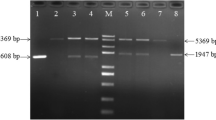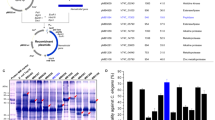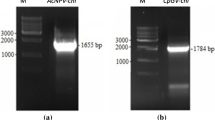Abstract
Nematodes are known to be harmful to various crops, vegetables, plants and insects. The present study reports that, chitin upregulates the activity of chitinase (20%) and nematicidal potential (15%) of Pseudomonas aeruginosa. The chitinase gene (pachi) from P. aeruginosa was cloned and its nematicidal activity of pachi protein against Caenorhabditis elegans was studied. The mortality rate induced by pachi increased by 6.3-fold when in association with Cry21Aa from Bacillus thuringiensis. Pachi efficiently killed C. elegans in its native state (LC50 = 387.3 ± 31.7 μg/ml), as well as in association with Cry21Aa (LC50 = 30.9 ± 4.1 μg/ml), by degrading the cuticle, egg shell and intestine in a relatively short time period of 24 h. To explore the nematidal potential of chitinase, six fusion proteins were constructed using gene engineering techniques. The CHACry showed higher activity against C. elegans than others owing to its high solubility. Notably, the CHACry showed a synergistic factor of 4.1 versus 3.5 a mixture [1:1] of pachi and Cry21Aa. The present study has identified eco-friendly biological routes (e.g., mixed proteins, fusion proteins) with potent nematicidal activity, which not only can help to prevent major crop losses but also strengthen the agro-economy and increase gross crop yield.
Similar content being viewed by others
Introduction
Nematodes infect the root, stem and leaves of cultural crops, leading to plant wilting, chlorosis, reduced growth and ultimately death, resulting in major economic losses. In order to control nematodes, various chemicals have been used worldwide. These chemicals not only are toxic to the plants but also have various harmful effects on human health and the environment1. Gene engineering has opened new gateways to develop nontoxic bio-control agents that are effective in protecting from nematodiasis2. In the study of bio-control of nematodiasis, C. elegans has been used widely as an important model organism owing to its genetic manipulability and short life cycle3,4. A literature survey revealed that some nematophagous bacteria were effective in killing nematodes. For example, Bacillus thuringiensis, Pseudomonas and Xenorhabdus nematohilus, found in the rhizosphere of plants, showed high nematicidal activity12 and Clonostachys rosea13, which killed nematodes via egg shell digestion and cuticle hydrolysis7. As chitin was the main component of the egg shell and cuticle of nematodes and acted as a target for these nematicidal factors14, chitin and chitosan were incorporated into the soil to reduce nematode infection by inducing rhizobacteria to produce chitinase15. Pseudomonas was an important rhizobacteria strain, which could produce some hydrolases (protease and chitinase) in killing nematodes16,17,Protein expression and purification E. coli BL21 (DE3) cells harboring pGEX-6p-pachi, named DE3/pGEX-6p-pachi, were inoculated into LB broth (ampicillin; 100 μg/ml) with shaking at 37 °C for 12 h. The seed culture was used to inoculate production broth (v/v, 2/100) and growth was induced by adding IPTG (1 mM) after 2–3 h. The IPTG-induced production broth was incubated at 18 °C for 14 h with shaking (250 rpm/min). Finally, the induced cells were collected by centrifugation, resuspended in phosphate-buffered saline (PBS) buffer (NaCl 0.8%, KCl 0.02%, Na2HPO4 0.14%, KH2PO4 0.03%; pH 7.0) and homogenized using a high-pressure homogenizer (NS100IL 2K, Niro Soavi, Germany). The target proteins (Cry21Aa, pachi and CHACry) were purified using a glutathione S-transferase (GST) Gene Fusion System (GE Healthcare, USA) and eluted from the GST tag by 3C proteases (PreScission, Pharmacia). The molecular weight was analyzed by SDS-PAGE with 10% polyacrylamide gels. The protein concentration was measured by the Bradford method using bovine serum albumin (BSA) as a standard. The purified proteins were used for bioassays including quantitative mortality tests, brood size assays and growth analyses. The bioassay procedures and 50% lethal/inhibition/growth concentration (LC50/IC50/GC50) evaluations were undertaken according to the method of Bischof et al.52. The cuticle was separated from the nematode body as described by Cox et al.14. Cuticles (eggs) was incubated with pachi at 20 °C and 37 °C for various time periods. The L4 worms were incubated with pachi, Cry21Aa and the CHACry fusion protein at 20 °C and 37 °C for various time periods. Pachi was used to study complete digestion at 1 mg/ml for the cuticle and at 200 μg/ml for the egg shell and intestine. The effects of Cry21Aa on the intestine were assessed at a final concentration of 150 μg/ml, while CHACry was assessed at 100 μg/ml. Pachi (1 mg/ml) was used as an effective nematicidal dose to ensure the complete killing of C. elegans. The synergistic factor was calculated by the formula of Tabashnik et al.53: 1/LC50(m) = Ra/LC50(a) + Rb/LC50(b), where Ra and Rb indicate the percentage of toxin A and toxin B proteins used in the final mixture; LC50(a) and LC50(b) represent the LC50 values for each toxin and LC50(m) is the expected theoretical value of LC50 calculated from the formula above. The real LC50 value was calculated from the bioassay for the observed toxicity of the mixture. Synergism was indicated with a SF value of greater than 1. Independent experiments were repeated at least three times. All of the data obtained were analyzed using GraphPad Prism 5.0 and Excel 2003 software for figures and LC50 values. All of the values were expressed as the mean values ± standard deviation, with the statistical significance set at p < 0.05. To study the effect of each protein on nematodes and their body parts, images were captured using a 20X objective lens with confocal laser scanning microscopy on a Zeiss LSM 510 microscope (CLSM; Zeiss LSM 510) imaging. Mixture of diethyl ether/ethanol absolute (1:1) was used as anaesthetic treatment to keep worms static during image capture. All pictures were processed using Photoshop 7.0 software and the worm sizes were calculated using ImageJ 2.4.1.7. The nucleotide sequences of Pseudomonas aeruginosa 16S and pachi have been submitted to GeneBank under accession numbers KR007310 (16S) and KR007311 (pachi).Quantitative analysis of nematicidal activity
Cuticle and egg shell digestion
Synergistic activity assays for pachi and Cry21Aa in L4 worms of the N2 strain
Statistical analysis
Image analysis by confocal microscopy
Nucleotide sequence accession number
Additional Information
How to cite this article: Chen, L. et al. Enhanced nematicidal potential of the chitinase pachi from Pseudomonas aeruginosa in association with Cry21Aa. Sci. Rep. 5, 14395; doi: 10.1038/srep14395 (2015).
References
Lifshitz, M. & Gavrilov, V. Central nervous system toxicity and early peripheral neuropathy following dermal exposure to methyl bromide. ClinToxicol 38, 799–801 (2000).
Opperman, C. H., Acedo, G. N., Saravitz, D. M., Skantar, A. M., Song, W. et al. Bioengineering resistance to sedentary endoparasitic nematodes. Advances in Molecular Plant Nematology 221–230 (Springer, 1994).
Kaletta, T. & Hengartner, M. O. Finding function in novel targets: C. elegans as a model organism. Nat Rev Drug Discov 5, 387–398 (2006).
Leung, M. C., Williams, P. L., Benedetto, A., Au, C., Helmcke, K. J. et al. Caenorhabditis elegans: an emerging model in biomedical and environmental toxicology. Toxicol Sci 106, 5–28 (2008).
Li, B., **e, G. L., Soad, A. & Coosemans, J. Suppression of Meloidogyne javanica by antagonistic and plant growth-promoting rhizobacteria. J Zhejiang Univ Sci B 6, 496–501 (2005).
Samaliev, H. Y., Andreoglou, F. I., Elawad, S. A., Hague, N. G. & Gowen, S. R. The nematicidal effects of the bacteria Pseudomonas oryzihabitans and Xenorhabdus nematophilus on the root-knot nematode Meloidogyne javanica. Nematology 2, 507–514 (2000).
Yang, J., Liang, L., Li, J. & Zhang, K. Nematicidal enzymes from microorganisms and their applications. Appl Microbiol Biotechnol 97, 7081–7095 (2013).
Wei, J. Z., Hale, K., Carta, L., Platzer, E., Wong, C. et al. Bacillus thuringiensis crystal proteins that target nematodes. P NATL ACAD SCI 100, 2760–2765 (2003).
Boonserm, P., Mo, M., Angsuthanasombat, C. & Lescar, J. Structure of the functional form of the mosquito larvicidal Cry4Aa toxin from Bacillus thuringiensis at a 2.8-angstrom resolution. J Bacteriol 188, 3391–3401 (2006).
Bravo, A., Gomez, I., Conde, J., Munoz-Garay, C., Sanchez, J. et al. Oligomerization triggers binding of a Bacillus thuringiensis Cry1Ab pore-forming toxin to aminopeptidase N receptor leading to insertion into membrane microdomains. BBA-Biomembranes 1667, 38–46 (2004).
Soares, F. E. D. F., Queiroz, J. H. D., Araújo, J. V. D., Queiroz, P. V., Gouveia, A. d. S. et al. Nematicidal action of chitinases produced by the fungus Monacrosporium thaumasium under laboratorial conditions. Biocontrol Sci Techn 25, 1–17 (2015).
Ahmed, M., Laing, M. & Nsahlai, I. Use of Clonostachys rosea against sheep nematodes develo** in pastures. Biocontrol Sci Techn 24, 389–398 (2014).
Cox, G. N., Kusch, M. & Edgar, R. S. Cuticle of Caenorhabditis elegans: its isolation and partial characterization. J Cell Biol 90, 7–17 (1981).
Radwan, M. A., Farrag, S. A. A., Abu-Elamayem, M. M. & Ahmed, N. S. Extraction, characterization and nematicidal activity of chitin and chitosan derived from shrimp shell wastes. Biol Fert Soils 48, 463–468 (2011).
Singh, N., Kumar, S., Bajpai, V. K., Dubey, R. C., Maheshwari, D. K. et al. Biological control of Macrophomina phaseolina by chemotactic fluorescent Pseudomonas aeruginosa PN1 and its plant growth promotory activity in chir-pine. Crop Prot 29, 1142–1147 (2010).
Ali, N. I., Siddiqui, I. A., Shahid Shaukat, S. & Zaki, M. Nematicidal activity of some strains of Pseudomonas spp. Soil Biol Biochem 34, 1051–1058 (2002).
Yorgey, P., Rahme, L. G., Tan, M. W. & Ausubel, F. M. The roles of mucD and alginate in the virulence of Pseudomonas aeruginosa in plants, nematodes and mice. Mol Microbiol 41, 1063–1076 (2001).
Yu, Z., Luo, H., **ong, J., Zhou, Q., **a, L. et al. Bacillus thuringiensis Cry6A exhibits nematicidal activity to Caenorhabditis elegans bre mutants and synergistic activity with Cry5B to C. elegans. Lett Appl Microbiol 58, 511–519 (2014).
Peng, D., Chai, L., Wang, F., Zhang, F., Ruan, L. et al. Synergistic activity between Bacillus thuringiensis Cry6Aa and Cry55Aa toxins against Meloidogyne incognita. Microbial Biotechnol 4, 794–798 (2011).
Luo, X., Chen, L., Huang, Q., Zheng, J., Zhou, W. et al. Bacillus thuringiensis metalloproteinase Bmp1 functions as a nematicidal virulence factor. Appl Environ Microb 79, 460–468 (2013).
Fang, W., Feng, J., Fan, Y., Zhang, Y., Bidochka, M. J. et al. Expressing a fusion protein with protease and chitinase activities increases the virulence of the insect pathogen Beauveria bassiana. J Invertebr Pathol 102, 155–159 (2009).
Ding, X., Luo, Z., **a, L., Gao, B., Sun, Y. et al. Improving the insecticidal activity by expression of a recombinant cry1Ac gene with chitinase-encoding gene in acrystalliferous Bacillus thuringiensis. Curr Microbiol 56, 442–446 (2008).
Chen, L., Chen, J., Kumar, A. & Liu, Z. Effects of domains modification on the catalytic potential of chitinase from Pseudomonas aeruginosa. Int J Biol Macromol 78, 266–272 (2015).
Ntalli, N. G., Ferrari, F., Giannakou, I. & Menkissoglu-Spiroudi, U. Synergistic and antagonistic interactions of terpenes against Meloidogyne incognita and the nematicidal activity of essential oils from seven plants indigenous to Greece. Pest Manag Sci 67, 341–351 (2011).
Rahme, L., Stevens, E., Wolfort, S., Shao, J., Tompkins, R. et al. Common virulence factors for bacterial pathogenicity in plants and animals. Science 268, 1899–1902 (1995).
Rahme, L. G., Tan, M. W., Le, L., Wong, S. M., Tompkins, R. G. et al. Use of model plant hosts to identify Pseudomonas aeruginosa virulence factors. P Natl Acad Sci 94, 13245–13250 (1997).
Jander, G., Rahme, L. G. & Ausubel, F. M. Positive correlation between virulence of Pseudomonas aeruginosa mutants in mice and insects. J Bacteriol 182, 3843–3845 (2000).
Huang, C., Wang, T., Chung, S. & Chen, C. Identification of an antifungal chitinase from a potential biocontrol agent, Bacillus cereus 28-9. J Biochem Mol Biol 38, 82–88 (2005).
Kalbe, C., Marten, P. & Berg, G. Strains of the genus Serratia as beneficial rhizobacteria of oilseed rape with antifungal properties. Microbiol Res 151, 433–439 (1996).
Gaffney, T. D., Lam, S. T., Ligon, J., Gates, K., Frazelle, A. et al. Global regulation of expression of antifungal factors by a Pseudomonas fluorescens biological control strain. Mol Plant Microbe In 7, 455–463 (1994).
Mahadevan, B. & Crawford, D. L. Properties of the chitinase of the antifungal biocontrol agent Streptomyces lydicus WYEC108. Enzyme Microb Tech 20, 489–493 (1997).
Theis, T. & Stahl, U. Antifungal proteins: targets, mechanisms and prospective applications. Cell Mol Life Sci 61, 437–455 (2004).
Qin, Y., Ying, S.-H., Chen, Y., Shen, Z.-C. & Feng, M.-G. Integration of insecticidal protein Vip3Aa1 into Beauveria bassiana enhances fungal virulence to Spodoptera litura larvae by cuticle and per os infection. Appl Environ Microb 76, 4611–4618 (2010).
Gan, Z., Yang, J., Tao, N., Liang, L., Mi, Q. et al. Cloning of the gene Lecanicillium psalliotae chitinase Lpchi1 and identification of its potential role in the biocontrol of root-knot nematode Meloidogyne incognita. Appl Microbiol Biot 76, 1309–1317 (2007).
Mercer, C., Greenwood, D. & Grant, J. Effect of plant and microbial chitinases on the eggs and juveniles of Meloidogyne hapla Chitwood (Nematoda: Tylenchida). Nematologica 1, 227–236 (1992).
Pardo-Lopez, L., Munoz-Garay, C., Porta, H., Rodríguez-Almazán, C., Soberón, M. et al. Strategies to improve the insecticidal activity of Cry toxins from Bacillus thuringiensis. Peptides 30, 589–595 (2009).
Tantimavanich, S., Pantuwatana, S., Bhumiratana, A. & Panbangred, W. Cloning of a chitinase gene into Bacillus thuringiensis subsp. aizawai for enhanced insecticidal activity. J Gen Appl Microbiol 43, 341–347 (1997).
Wiwat, C., Lertcanawanichakul, M., Siwayapram, P., Pantuwatana, S. & Bhumiratana, A. Expression of chitinase-encoding genes from Aeromonas hydrophila and Pseudomonas maltophilia in Bacillus thuringiensis subsp. israelensis. Gene 179, 119–126 (1996).
Driss, F., Kallassy-Awad, M., Zouari, N. & Jaoua, S. Molecular characterization of a novel chitinase from Bacillus thuringiensis subsp. kurstaki. J Appl Microbiol 99, 945–953 (2005).
Okay, S., Tefon, B., Özkan, M. & Özcengiz, G. Expression of chitinase A (chiA) gene from a local isolate of Serratia marcescens in Coleoptera-specific Bacillus thuringiensis. J Appl Microbiol 104, 161–170 (2008).
Cai, Y., Yan, J., Hu, X., Han, B. & Yuan, Z. Improving the insecticidal activity against resistant Culex quinquefasciatus mosquitoes by expression of chitinase gene chiAC in Bacillus sphaericus. Appl Environ Microb 73, 7744–7746 (2007).
Borgonie, G., Claeys, M., Vanfleteren, J., Waele, D. D. & Coomans, A. Presence of peritrophic-like membranes in the intestine of three bacteriophagous nematodes (Nematoda: Rhabditida). Fundam Appl Nematol 18, 227–233 (1995).
Pyati, P., Fitches, E. & Gatehouse, J. A. Optimising expression of the recombinant fusion protein biopesticide omega-hexatoxin-Hv1a/GNA in Pichia pastoris: sequence modifications and a simple method for the generation of multi-copy strains. J Ind Microbiol Biot 41, 1237–1247 (2014).
Tajne, S., Boddupally, D., Sadumpati, V., Vudem, D. R. & Khareedu, V. R. Synthetic fusion-protein containing domains of Bt Cry1Ac and Allium sativum lectin (ASAL) conferred enhanced insecticidal activity against major lepidopteran pests. J Biotechnol 1, 71–75 (2014).
Yan, F., Cheng, X., Ding, X., Yao, T., Chen, H. et al. Improved insecticidal toxicity by fusing Cry1Ac of Bacillus thuringiensis with Av3 of Anemonia viridis. Curr Microbiol 68, 604–609 (2014).
Fahnert, B., Lilie, H. & Neubauer, P. Inclusion bodies: formation and utilisation. Physiological Stress Responses in Bioprocesses 93–142 (Springer, 2004).
Wang, F., Liu, Y., Zhang, F., Chai, L., Ruan, L. et al. Improvement of crystal solubility and increasing toxicity against Caenorhabditis elegans by asparagine substitution in block 3 of Bacillus thuringiensis crystal protein Cry5Ba. Appl Environ Microb 78, 7197–7024 (2012).
Tan M. W., A. F. M. Caenorhabditis elegans a model genetic host to study Pseudomonas aeruginosa pathogenesis. Curr Microbiol 3, 29–34 (2000).
Venturi, V. Regulation of quorum sensing in Pseudomonas. FEMS Microbiol Rev 30, 274–291 (2006).
Kipnis, E., Sawa, T. & Wiener-Kronish, J. Targeting mechanisms of Pseudomonas aeruginosa pathogenesis. Med Maladies Infect 36, 78–91 (2006).
Folders, J. et al. Characterization of Pseudomonas aeruginosa chitinase, a gradually secreted protein. J Bacteriol 183, 7044–7052 (2001).
Bischof, L. J., Huffman, D. L. & Aroian, R. V. Assays for toxicity studies in C. elegans with Bt crystal proteins. C. elegans. 139–154 (Springer, 2006).
Tabashnik, B. E. Evaluation of synergism among Bacillus thuringiensis toxins. Appl Environ Microb 58, 3343–3346 (1992).
Acknowledgements
This work was supported by grants from National Basic Research Program (973) of China (2013CB127504) and the China 948 Program of Ministry of Agriculture (2011-G25).
Author information
Authors and Affiliations
Contributions
L.C. designed the experiments and wrote the manuscript. L.C. and J.C. performed the experiments. L.C. analyzed the data. H.J., Q.C., J.C., A.K., G.W., Z.L. and M.S. contributed reagents/materials/analysis tools.
Ethics declarations
Competing interests
The authors declare no competing financial interests.
Electronic supplementary material
Rights and permissions
This work is licensed under a Creative Commons Attribution 4.0 International License. The images or other third party material in this article are included in the article’s Creative Commons license, unless indicated otherwise in the credit line; if the material is not included under the Creative Commons license, users will need to obtain permission from the license holder to reproduce the material. To view a copy of this license, visit http://creativecommons.org/licenses/by/4.0/
About this article
Cite this article
Chen, L., Jiang, H., Cheng, Q. et al. Enhanced nematicidal potential of the chitinase pachi from Pseudomonas aeruginosa in association with Cry21Aa. Sci Rep 5, 14395 (2015). https://doi.org/10.1038/srep14395
Received:
Accepted:
Published:
DOI: https://doi.org/10.1038/srep14395
- Springer Nature Limited




